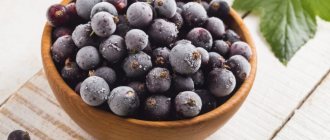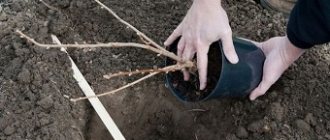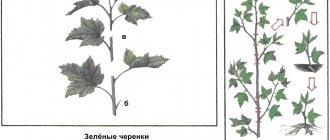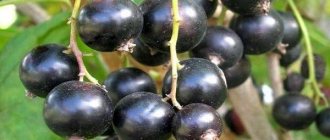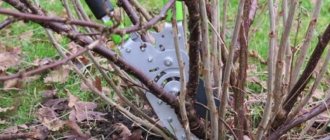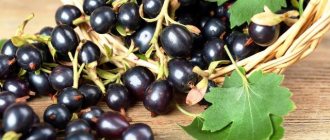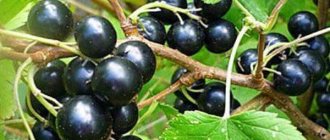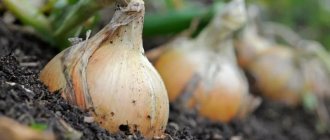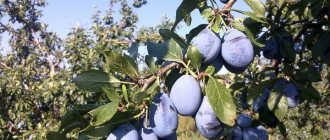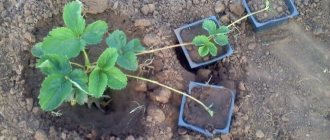Botanical description
The currant variety Lazy (or Lazy) is represented by a powerful, vigorous shrub, reaching 180 cm in height. The crown is dense, medium spreading. The shoots are slightly curved, thick, smooth. The bark of young branches has a greenish tint, while old branches are covered with brownish-gray bark. The buds are cone-shaped, purple-pink in color and medium in size, located asymmetrically on the branches. The leaf blades are quite large, five-lobed, slightly wrinkled, dark green in color.
The flowers are medium-sized and resemble bells. Approximately 8-9 shiny fruits grow on the cluster. The berry has a moderately thin skin, colored black.
Reviews
Marina
We spent a long time choosing which currants to try to plant, and settled on the “Lazy” variety. We planted three bushes in the dacha. By the way, an important point in planting is to make enough distance between the bushes so that they can grow freely. I was pleased with the harvest; the berries were very sweet, juicy and tasty. We are pleased with the result.
Sergey 89
I planted several bushes of this currant more than four years ago. Every year I collect almost 9 liters from one. The shell of the berry is quite thin, but does not burst when picked. I recommend planting in garden plots.
Characteristic
Over the past two decades, the Lazy currant variety has earned many good reviews from gardeners. This popularity is explained by the excellent taste of the berries and the simple care of the bush. Tender and aromatic fruits are suitable for consumption fresh, frozen and canned. The following is a detailed description of the characteristic features of Lazy.
Drought resistance, frost resistance
The Lazy Tree variety can withstand a significant decrease in air temperature - the bush tolerates frosts down to -34°C. The dry summer season is also not terrible for the bush. Resistance to cold and drought makes currant cultivation easy even for novice gardeners.
Did you know? In Rus', the name of currant comes from the word “stench”. The fact is that a berry bush, especially the black variety, emits a strongly pronounced characteristic odor.
Productivity and fruiting
If all planting and care rules are followed, one bush on average is capable of producing 3.9–4 kg of fruit. Currants begin to bear fruit in the second year after planting. The fruiting period is quite long - if agricultural practices are followed, it will be about 20 years.
In terms of ripening time, the variety is considered medium-late. This form of currant got its name due to the somewhat delayed ripening of the berries.
The fruits can be collected from the end of July to the end of August, in several stages
Berry size, taste
The fruits of the Lazyberry currant are of different sizes, generally large. Weight ranges from 1.7 to 3.6 g.
The pulp has a dense structure, a sweet dessert taste, and a pleasant aroma. There is no sourness in the taste. The tasting score is 4.8 points.
Find out about the benefits and harms of blackcurrant for the human body.
Advantages and disadvantages
- Among the main advantages of the Lazy currant, gardeners highlight:
- resistance to temperature changes and frosty winters (up to -34...-35°C);
- good yield;
- widespread use of berries in cooking;
- immunity to infections and viruses that affect most forms of currants;
- the possibility of harvesting using technological means.
- Unfortunately, the variety also has many disadvantages:
- uneven ripening of fruits;
- different sizes of berries may require sorting;
- very ripe fruits may crumble and lose their taste;
- fruits do not tolerate transportation over long distances;
- The variety is unprofitable to cultivate for sale.
Advantages and disadvantages
This variety of black currant has its own pros and cons, like any other berry crop.
Advantages:
- Early ripening of berries.
- Up to 10 large fruits of the same size are formed in the brush.
- It is a cold-resistant crop that can withstand bitter frosts down to -23-25 C. The variety does not require mulch bedding for the winter, especially in the southern regions.
- Resistant to fungal diseases, attacks of harmful insects, for example, bud mites, grouse.
- Good yield, from 1 hectare you can collect up to 6.3-65 tons of berries, and from one bush up to 4-5 kg.
Flaws:
- The berry crop ages quickly, for this reason it is necessary to frequently rejuvenate the bushes by pruning. The procedure is done every year.
- To increase the fruiting of a variety, it is necessary to properly care for the plant. If this is not done, the harvest will be minimal.
- The thin skin of the fruit makes it difficult to transport them over long distances.
Berry composition
Berry culture is rich in vitamins. For example, 100 g of black currant contains 102 mg of vitamin C, ascorbic acid - 90 mg, and saccharides - more than 8%. The acidity in the berries reaches 2.5%, and the dry matter reaches 14.5%.
Application
Black currants can be stored without much loss at a temperature of +10-12C for two weeks. And at temperatures from 0C to +10C – up to one month. Berries are useful to eat both fresh and canned. They make delicious preserves, jams, compotes or marmalade. Read about the use of the Shchedraya currant variety at this link.
Landing Features
In the cultivation of Lazyberry currants, competent implementation of planting measures is of paramount importance. Only in this case will the seedling settle well in your garden and regularly delight you with delicious fruits. First of all, you need to decide on the timing, as well as select a location on the site and the planting material itself. And further care of the young plant involves timely watering, fertilizing, pruning and shelter for the winter.
Deadlines
Planting can be done in spring or autumn. Experienced gardeners advise choosing autumn planting. If you plant the Lazy Tree variety in the fall (in October, about 2 weeks before the first frost), the shrub will have enough time to take root and adapt to new conditions.
Important! Spring planting is dangerous because the roots may not have time to grow and become stronger, and the growing season will begin too early. In such conditions, a young bush may not survive.
Conditions
To achieve a high-quality harvest, the Lazy Tay currant variety must be provided with bright lighting and protection from drafts. It is advisable to place the seedlings along the fence, but on the sunny side. The fence will serve as a kind of protective shield from the wind.
Choosing a suitable location
When choosing a planting area, heavy soil should be avoided. Choose areas with a predominant clay content and a significant amount of sand.
You can also use sandy loam and slightly podzolic soils - they perfectly transmit oxygen and moisture to the root system.
The acidity level must be strictly within the range of 6–6.5 pH.
In addition, the currant must have the correct predecessor. This will avoid infection with various fungal infections. Preference is given to winter and legume crops.
Find out everything about the large-fruited black currant variety Bagheera.
Selection and preparation of seedlings
Seedlings of the Lazy Tree variety are very difficult to find on the market; they are usually purchased at a nursery. In order not to make a mistake in choosing planting material, when purchasing, pay close attention to its appearance. The rhizomes and branches should be free of any damage, as well as rot and mold. The bark of the plant should be even and smooth.
Before planting, the roots of young plants are dipped in containers with water. In 2-3 hours they will be saturated with the necessary moisture.
Landing algorithm
A seedling of the Lazy Tree variety is planted according to the following proven scheme:
- Form a hole 35–40 cm deep and 50–60 cm in diameter. The distance between bushes should be 1 m, and between rows - 1.8–2 m.
- Fill the hole approximately 3/4 of the depth with fertile soil mixed with a bucket of compost, 200 g of superphosphate, and 50 g of wood ash.
- Lower the seedling into the hole, spreading the roots evenly along the bottom. The plant should be rooted at an angle of 45 degrees. And the zone of transition of the root to the trunk should be buried 5 cm below the ground level.
- Carefully fill the top of the hole with soil mixed with compost.
- The final stage of planting is watering - pour at least 2 liters of water under the bush.
How to plant a plant on the site
When planting Lazyberry currants, it is necessary to observe a number of nuances. To get a good harvest, it is important to choose the optimal time for planting, prepare a place at your summer cottage and step-by-step carry out the technology of transferring seedlings to the soil.
The best time to carry out planting work
It is recommended to transfer Lazy Blackcurrant seedlings into the ground in the second half of October, before the onset of the first frost. During the winter period, the plants adapt to new conditions, and the roots are firmly compacted into the ground. In the spring, after most of the snow cover has melted, young shoots will begin to actively grow.
Choosing the optimal location
The area for planting currant crops must be constantly illuminated, since the effect of ultraviolet rays on the bushes has a beneficial effect on the taste characteristics and quantity of the harvest. The optimal place on the site is a line along a fence or building, protected from through blowing. If the site is located on an elevated area, it is better to plant bushes in the central or lower part of the slope.
Suitable predecessor crops for Lazy currants are green manure, legumes and winter rye. The Lazy Tree variety requires slightly acidic soil of loamy, slightly podzolic or sandy loam type.
Preparing the soil and planting hole
Having chosen a place to place the seedlings, it is necessary to prepare the soil for rapid rooting of plants. The process of preparing a planting hole requires the following steps:
- Clear the area of weeds, debris and plant debris.
- A couple of weeks before planting, treat the soil with rotted manure or compost, superphosphate, and potassium.
- Dig holes to accommodate currant seedlings up to 50 cm deep and twice the diameter of the roots. The distance between the pits should be 1-1.5 m between each other and 2.5-3 m between the rows.
- Sprinkle the bottom of the holes with chalk, wood ash, dried plaster or shells in order to lime the acidified soil.
- Wait 2-3 weeks and plant currant bushes.
Technology of planting seedlings
Before transferring currant seedlings into the ground, the plant roots are kept in warm water to soften. Immediately before planting, the holes are moistened. Currant seedlings are placed in the holes at a slight angle and the roots are evenly distributed at the bottom. Leave the root collar at a level of 5-7 cm below the soil level. The plants are sprinkled with soil mixed with rotted manure and the root area is watered. To retain moisture in the soil and protect plants, the hole is covered with a 5-8 cm layer of mulch made from straw, peat, and pine branches. The ground part of the seedlings is pruned, leaving 3-4 powerful buds.
Valentina grapes: variety description, photos, reviews
What can you plant nearby?
The most favorable proximity is guaranteed with yoshta, strawberries, honeysuckle, apple trees, garlic, onions, and most herbs. It is these crops that have a structural composition similar to black currant.
Care
It is not difficult to care for this fruit crop; you just need to comply with a number of conditions:
- Watering. It is important to consider here that overwatering will weaken the bush. And from a lack of water, it will stop growing and begin to wither. Starting from March and until the middle of the summer season, moisten the plantings 2 times a week. Pour one bucket of water under each plant. In addition to flooding, the method of sprinkling or watering using a drainage receiver is popular among experienced gardeners.
- Feeding. The nutrients added to the planting hole when planting the seedling should be enough for 2 years. In the spring of the third year, urea is used (40–50 g per 10 liters of water under the bush). At the age of 3-4 years, currants need humus (8 kg per 1 m²), potassium sulfate (30–40 g per 1 m²), double superphosphate (70–80 g per 1 m²).
- Trimming. For the first time, the bush undergoes this procedure immediately after planting. There should be no more than 4 buds left on it. The following fall, all broken and weak canes are removed. Strong and durable stems, which have 4 buds, are left unaffected. In the fourth year after planting, the shrub is subjected to sanitary pruning - non-viable and diseased branches are removed.
Feeding currant bushes of the Lazy variety
Both organic and mineral fertilizers are suitable as fertilizers for Lazy Guy
. For optimal effect it is worth alternating.
Currant bushes, the age of which has not yet exceeded 3 years, are fertilized in the spring with urea (40 g). It is simply buried under the bush to a depth of 30 cm. Nitrogen fertilizers are used to stimulate the growth of shoots. When plants are older than 3 years, only 25 grams of urea is enough.
On a note!
After the currants have already bloomed, they need phosphorus and potassium. For 10 liters of water take 20 grams of potassium salt, 40 grams of superphosphate.
How to feed currants in spring
Every couple of years, they dig under the bushes and add humus as a top dressing for currants.
. If organic matter is used for mulching, you do not need to add humus to the soil.
Preparing for winter
You need to prepare the berry garden for wintering after the soil underneath it freezes and hardens. The area should be completely cleared of plant remains that serve as a refuge for pathogenic microflora, insects and sucking pests.
Did you know? A natural dye is made from blackcurrant, widely used in food production.
First of all, the plants are tied with twine from the base to the top. This measure allows you to save the lashes from breaking under the weight of snow. With the first heavy snowfall, cover the bushes with a snow coat. Throughout the winter season, periodically hill up the berry garden as snow accumulates.
Reproduction methods
Lazy black currant is successfully propagated by cuttings . Separated parts of the plant can be green, semi- or completely woody. In the second half of September, shoots cut from the bush are divided into cuttings 15 cm long, with five buds on each. The cuts should be smooth, so it is best to make them with a sharp garden knife. For better rooting, the separated parts are placed in water for several hours before planting.
Cuttings are planted in open ground at an angle of 45 degrees. Make sure that 2 buds are located above the ground. The soil needs to be compacted, mulched with organic matter, then moistened and loosened. By winter, the cuttings will take root, and with the arrival of spring, their active growth will begin.
by layering is also popular . But keep in mind that you will get only a few seedlings. Next to the branch, you need to dig a hole 10-11 cm deep, bend the whip there and sprinkle it with earth so that approximately 20-25 cm remains outside. The layering is attached to a small peg. Care involves frequent watering. Already in the fall it will be possible to transplant it to a new place.
dividing a bush is also practiced . Plants are dug up and divided into parts with 2-3 branches. Each division must have roots. The shoots must be shortened by 3/4 of their length, then deepened by 5–7 cm.
Important! By dividing the bush, currants are propagated in exceptional cases, for example, when redeveloping a site or moving it to a new location. But it is important that the plant is more than 6 years old.
When to plant Lazy currants
The best time for planting is the end of September, when the leaves have already fallen.
. Sometimes they reschedule until the spring. You must wait until the snow melts. The soil should warm up well.
The first step is to prepare the pit, after which they wait 14-21 days. This time is necessary for the soil to settle.
Procedure for planting currants:
- Dig a planting hole up to half a meter in diameter and 40 cm deep.
- The soil is diluted with compost and superphosphate. A couple of buckets of compost contain 100 grams of superphosphate.
- Pour the substrate into the hole.
- 24 hours before planting currants, place the roots of the plant in a container with clean water.
- After a day, the currants are planted on the site, sprinkling the root system with soil.
- Water the bush abundantly (always with warm water).
- The shoots are shortened, leaving two or three buds on each.
Photo of Lazy currant
Watering of planted currant seedlings is carried out weekly. Humus is used for mulching. In winter, the bushes are hilled up to protect them from freezing.
Diseases and pests
Despite its high immunity, large shrubs can suffer from ailments and harmful insects such as:
- Anthracnose. The leaf blades are covered with brown spots and tubercles. To protect and rid the crop of disease, the fungicide “Nitrafen” (300 g of product per 10 liters of water) is suitable.
- White spotting. Brown spots appear on the foliage and fruits, which soon turn white. For the purpose of prevention and therapy, Bordeaux mixture is used (on average, 5 liters of solution per 100 m² is required) and Nitrafen.
- Striped mosaic and terry. There are no effective methods to combat these diseases. Affected bushes must be uprooted. However, infection can be prevented if you plant exclusively healthy planting material and do not forget about disinfection of garden tools.
- Spider mite, two-year fruit sawfly. The insecticides “Aktara”, “Confidor” and “Koragen” help prevent the invasion of these pests and remove them.
Harvesting and storage
Start harvesting in the morning or evening. Since the ripening of blackcurrant fruits is not simultaneous, first it is necessary to remove the largest specimens, then the smaller ones.
Learn how to care for blackcurrant bushes in early spring.
For containers for berries, take trays, boxes or crates where they can be laid out in one layer. Immediately after harvesting, large volumes of the crop are placed in a cool place (basement or cellar). The shelf life under such conditions will be 1–2 months.
Berries can be stored in the refrigerator for about 4 days. Before this, they are laid out unwashed in one layer on a tray or in a container. And thanks to freezing, the fruits will retain their freshness, taste, aroma and most of their beneficial properties for up to a year.
Currants are consumed fresh or grated with sugar. It is also often used for preparing preparations for the winter - excellent jams, preserves, compotes, etc. are obtained.
Cultivating black currant variety Lazy Guy will not cause you unnecessary trouble. By taking into account just a few tips, even a novice gardener will be able to reap a decent harvest of this valuable and tasty berry. And a pearl scattering of shrub fruits will decorate any garden plot.
Currant pruning Lazy
Over time, Lazy, like other varieties of this crop, grows and the internal shoots no longer receive enough light. The result of this is a decrease in yield and a deterioration in the taste characteristics of the berry. Therefore, the Lazy currant requires pruning.
How to properly prune blackcurrants in spring
Every year, frozen, dry shoots are removed, as well as those that are diseased, and sanitary pruning is done.
. The main harvest of currants comes from annual shoots. In this regard, branches that are more than 4 years old are pruned.
Currant pruning occurs in early spring before the buds open or in the fall after the leaves have fallen.
. In summer, small root shoots are removed. It, like weeds, takes nutrients from the main plant.
Over time, the buds shift to the upper parts of the shoots. In spring, the upper parts of the currant are pinched to stop growth and produce strong shoots that form berry fruits.
